Biblical Jerusalem wall uncovered
Archaeologists looked for a biblical wall for years. Finally Israeli scholars have found it.

A team of archaeologists in Jerusalem has uncovered what they believe to be part of a wall mentioned in the Bible's Book of Nehemiah.
The discovery, made in Jerusalem's ancient City of David, came as a result of a rescue attempt on a tower which was in danger of collapse, said Eilat Mazar, head of the Institute of Archaeology at the Shalem Center, a Jerusalem-based research and educational institute, and leader of the dig.
Artifacts including pottery shards and arrowheads found under the tower suggested that both the tower and the nearby wall are from the 5th century B.C., the time of Nehemiah, according to Mazar. Scholars previously thought the wall dated to the Hasmonean period (142-37 B.C.).
The findings suggest that the wall is actually part of the same city wall the Bible says Nehemiah rebuilt, Mazar said. The Book of Nehemiah (chapters 3-6) gives a detailed description of construction of the walls, destroyed earlier by the Babylonians.
"We were amazed," she said, noting that the discovery was made at a time when many scholars argued that the wall did not exist.
"This was a great surprise. It was something we didn't plan," Mazar said.
However, another scholar doubted whether the wall was biblical.
The first phase of the dig, completed in 2005, uncovered what Mazar believes to be the remains of King David's palace, built by King Hiram of Tyre and also mentioned in the Bible.
Ephraim Stern, professor emeritus of archaeology at Hebrew University and chairman of the state of Israel archaeological council, corroborated Mazar's claim. "The material she showed me is from the Persian period," the period of Nehemiah, he said. "I can sign on the date of the material she found."
Another scholar disputed the significance of the discovery.
Israel Finkelstein, professor of archaeology at Tel Aviv University, called the discovery "an interesting find," but said the pottery and other remains do not indicate that the wall was built in the time of Nehemiah. Because the debris was not connected to a floor or other structural part of the wall, the wall could have been built later, Finkelstein said.
"The wall could have been built, theoretically, in the Ottoman period," he said. "It's not later than the pottery - that's all we know."
Subscribe to Pravda.Ru Telegram channel, Facebook, RSS!


